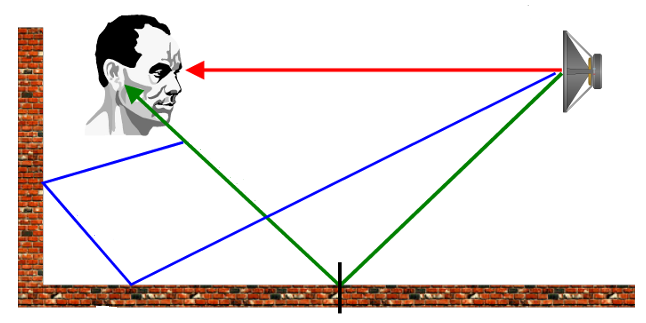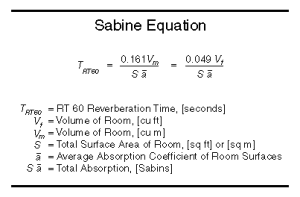Unit 3
Sound
According to classic acoustics theory there are five requirements which, when met, result in good acoustics:
- Appropriate reverberation time depends on the size of the room. W. Furrer’s recommendations can be used in rooms which are between 200 and 20,000 cubic metres. Unless it concerns a concert hall for classical music, the reverberation time must in so as far as possible be the same throughout the entire frequency range.
- Uniform sound distribution is important in large rooms and halls, where the sound must be able to be heard equally well everywhere. It is important to take sound distribution into account in the architecture. A variation of max. ±5 dB anywhere in the room is an appropriate requirement.
- Appropriate sound level for normal conversation is 60-65 dB, and in a busy street 70-85 dB. In large gatherings, a public address system in a dampened room can be used to ensure an appropriate sound level.
- Appropriate, low background noise is one of the most important acoustic criteria – especially in concert halls and theatres. In a room, the background noise may come from technical installations or ventilation systems.
- No echo or flutter echoes must occur for the acoustics to be good. It is easy to prevent echo by installing a little sound-absorbing material on the wall.
Reverberation is the phenomenon of persistence of sound after it has been stopped as a result of multiple reflections from surfaces such as furniture, people, air, etc. within a closed surface. These reflections build up with each reflection and decay gradually as they are absorbed by the surfaces of objects in the space enclosed.

It is the same as the echo, but the distance between the source of the sound and also the obstacle through which it gets reflected is less in case of this reverberation. The quantitative characterization of the reverberation is mainly done by using the parameter called reverberation time. Reverberation time is usually defined as the length of the time when the sound decays by about 60 decibels starting from the initial level. In the process of reverberation, the time delay is said to be not less than 0.1 second i.e. the reflected form of the wave reaches the observer in more or less than 0.1 seconds. Hence, this delay in the perception of the sound and also the original sound is said to be very less and whereas the original sound will be still in the memory when this reflected sound is heard.
The reverberant sound in an auditorium dies away with time as the sound energy is absorbed by multiple interactions with the surfaces of the room. In a more reflective room, it will take longer for the sound to die away and the room is said to be 'live'. In a very absorbent room, the sound will die away quickly and the room will be described as acoustically 'dead'. But the time for reverberation to completely die away will depend upon how loud the sound was to begin with, and will also depend upon the acuity of the hearing of the observer. In order to provide a reproducible parameter, a standard reverberation time has been defined as the time for the sound to die away to a level 60 decibels below its original level. The reverberation time can be modelled to permit an approximate calculation

Sabine equation
Sabine’s reverberation equation was developed in the late 1890s in an empirical fashion. He established a relationship between the RT60 of a room, its volume, and its total absorption (in sabins). This is given by the equation:
 .
.
Where  is the speed of sound in the room (for 20 degrees Celsius),
is the speed of sound in the room (for 20 degrees Celsius),  is the volume of the room in m³,
is the volume of the room in m³,  total surface area of room in m²,
total surface area of room in m²,  is the average absorption coefficient of room surfaces, and the product
is the average absorption coefficient of room surfaces, and the product  is the total absorption in sabins.
is the total absorption in sabins.
The total absorption in sabins (and hence reverberation time) generally changes depending on frequency (which is defined by the acoustic properties of the space). The equation does not take into account room shape or losses from the sound travelling through the air (important in larger spaces). Most rooms absorb less sound energy in the lower frequency ranges resulting in longer reverb times at lower frequencies.
Sabine concluded that the reverberation time depends upon the reflectivity of sound from various surfaces available inside the hall. If the reflection is coherent, the reverberation time of the hall will be longer; the sound will take more time to die out.
The reverberation time RT60 and the volume V of the room have great influence on the critical distance dc (conditional equation):

Where critical distance  is measured in meters, volume
is measured in meters, volume  is measured in m³, and reverberation time
is measured in m³, and reverberation time  is measured in seconds.
is measured in seconds.

The sound absorption coefficient is the ratio of absorbed sound intensity in an actual material to the incident sound intensity and can be expressed as
α = Ia / Ii
Where
α = sound absorption coefficient
Ia = sound intensity absorbed (W/m2)
Ii = incident sound intensity (W/m2)
The sound absorption coefficient varies with frequency.

Total Room Sound Absorption
The total sound absorption in a room can be expressed as
A = S1 α1 + S2 α2 + ... + Sn αn
= ∑ Si αi
Where
A = the absorption of the room (m2 Sabine)
Sn = area of the actual surface (m2)
αn = absorption coefficient of the actual surface
Mean Absorption Coefficient
The mean absorption coefficient for the room can be expressed as:
αm = A / S
Where
αm = mean absorption coefficient
S = total surface in the room (m2)
The acoustic characteristics of a room can be calculated with the formulas above, or estimated for typical rooms.
1 Reverberation
Reverberation is the persistence of sound in the enclosed spac , after the source of sound has stopped.
Reverberant sound is the reflected sound, as a result of improper absorption. Reverberation may result in confusion with the sound created
Remedies
The reverberation time can be controlled by the suitable choice of building materials and furnishing materials.Since, open windows allow the sound energy to flow out of the hall, there should be a limited number of windows. They may be opened or closed to obtain optimum reverberation time
2.Echo's
Echo's Not all sound that hits matter is absorbed. Some of it is reflected. That means sound bounces off the solid matter the way a tennis ball bounces off a wall. Sound reflected back to its source is an echo.
An echo is produced when the reflected sound wave reaches the ear just when the original sound from the same source has been already heard.Thus, there is repetition of sound. The sensation of sound persists for 1/10th of a second after the source has ceased. Thus, an echo must reach after 1/10th second of the direct sound
Remedies
This defect is avoided by selecting proper shape for the auditorium. Use of splayed side walls instead of parallel walls greatly reduces the problem and enhance the acoustical quality of the hall. Echoes may be avoided by covering the opposite walls and high ceiling with absorptive material.
3.sound foci
Sometimes shape of the hall makes sound waves to concentrate in some particular areas of hall creating a sound of large quality.These spots are called sound foci.
Remedies
This defect can be removed by Geometrical design shapes of the interior faces. Providing highly absorbent materials on critical areas (curved spaces)
4.dead spots
This defect is the outcome of formation of sound foci.Because of high concentration of reflected sound at sound foci, there is deficiency of related sound at some other points.These spots are known as dead spots where sound intensity is so low that it is insufficient for hearing.
Remedies
This defect can be removed by suitably placing diffusers and reflectors. Right proportions of internal spaces. External noises from vehicles, traffic engines,factories, machines etc. may enter the hall either through the openings or even through walls and other structural elements having improper sound insulation.
This defect can be removed by proper planning of the hall with respect to its surroundings and by proper sound insulation of external walls
5. Noise
Noise is unwanted sound which masks the satisfactory hearing of speech and music. There are mainly three types of noises that are to be minimized. They are (i) air-borne noise, (ii) structure-borne noise and (iii) internal noise.
Air-Borne Noise
The noise that comes into building through air from distant sources is called air-borne noise. A part of it directly enters the hall through the open windows, doors or other openings while another part enters by transmission throughwalls and floors.
Remedies
The building may be located on quite sites away from heavy traffic, market places, railway stations, airports etc. They may be shaded from noise by interposing a buffer zone of trees, gardens etc.
Structure-Borne Noise
The noise which comes from impact sources on the structural extents of the building is known- as the structure-borne noise. It is directly transmitted to the building by vibrations in the structure. The common sources of this type of noise are foot-steps, moving of furniture, operating machinery etc.
Remedies
The problem due to machinery and domestic appliances can be overcome by placing vibration isolators between machines and their supports. Cavity walls, compound walls may be used to increase the noise transmission loss.
Internal Noise
Internal noise is the noise produced in the hall or office etc. They are produced by air conditioners, movement of people etc.
Remedies
The walls, floors and ceilings may be provided with enough sound absorbing materials.The gadgets or machinery should be placed on sound absorbent material